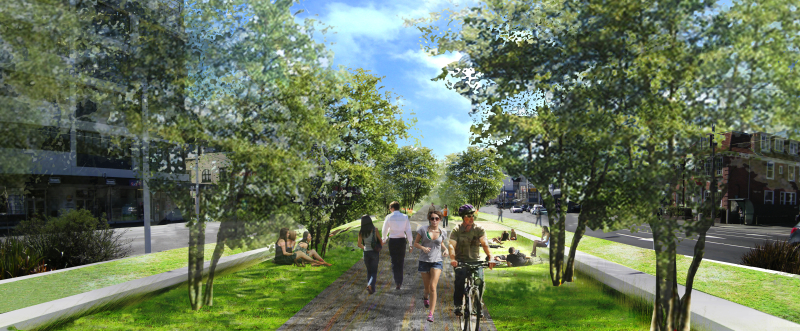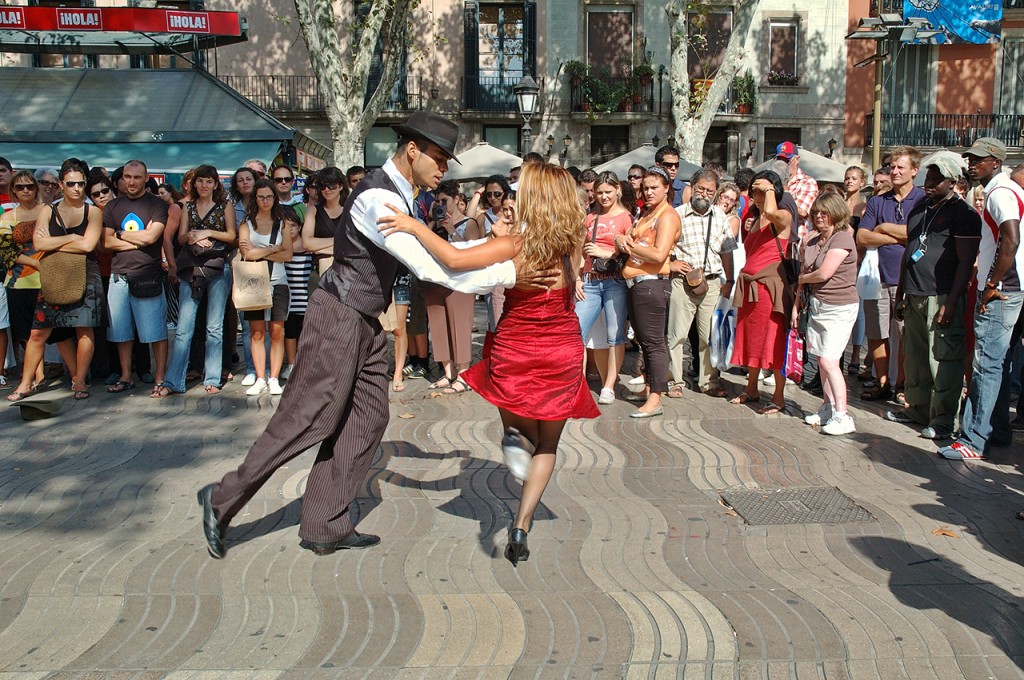After a couple of posts looking at the proposed concretisation of the car’s dominance over nature, with a 6 lane highway racing through Haitaitai and an overpass through / over / around the Basin Reserve, all courtesy of the NZTA, perhaps it is time to look at somebody else’s vision for the streets of Wellington. Why don’t we have a look at this image, number 3 in the series, on Boulevards:

This could be Kent Tce, or Cambridge Tce, or a bit of both. But what if it could be Taranaki St? Could it even be Tory St? We should ask Miley Cyrus, she’ll know. Wherever it is, it looks nice, and I want to go there now.
It is of course part of the WCC document on WGTN2040, or what the capital may look like in 30 years time: part of the WCC’s vision that was started off by the previous local body administration, under the leadership of Mayor Kerry Prendergast. I’m not 100% sure if the vision as published now under Mayor Celia Wade Brown, would have been just the same under Kerry – would there have been a different emphasis, or is it all by the Council officers and hence hands off by the elected politicos? I guess we’ll never really quite know.
The irony is, and it will not have escaped attention, that there is a massive gulf between what the WCC says it wants, and what the NZTA says that Wellington is going to get. The vision of a leafy biking / running track with happily picnic wielding couples having lunch on the lawn sits firmly at odds with a 6 lane highway and the occasional pedestrian crossing.
Of course, the NZTA proposal may well get swept up in a wave of regulatory Resource Consent hell, in which case it may well end up in the hands of the newly minted Environmental Protection Agency. Double irony here of course – the new head of the EPA is to be none other than Kerry Prendergast.
Time, perhaps, to take a brief diversion and examine exactly what is meant by a boulevard. The font of all human knowledge, Wikipedia, says that a
“Boulevard (French, from Dutch: Bolwerk – bolwark, meaning bastion) has several generally accepted meanings. It was first introduced in the French language in 1435 as boloard and has since been altered into boulevard. In this case, as a type of garden or a type of road, a boulevard (often abbreviated Blvd) is usually a wide, multi-lane arterial thoroughfare, divided with a median down the center, and roadways along each side designed as slow travel and parking lanes and for bicycle and pedestrian usage, often with an above-average quality of landscaping and scenery. The division into peripheral roads for local use and a central main thoroughfare for regional traffic is a principal feature of the boulevard. Larger and busier boulevards usually feature a median.”

The image of the Boulevard they give as the ultimate is the Champs-Elysees in Paris – apparently the most beautiful avenue in the world. Meh. I’m not so sure. Last time I was there it was all full of snooty French women and snooty French waiters, and featured a massive barrage of madly driven French cars tootling up and down the centre strip. Not really such a nice place to be, either in or out of a car.

There’s also another Boulevard of equally world famous proportions – but with a completely different feel about it. Even more at home with the motor-car than the Champs Elysees (named after the Elysian Fields – the place of the dead heroes in Greek mythology) is of course the Strip at the heart of Las Vegas. Less trees, more neon, but still lots of boulevarding.

I guess that the key thing at the heart of any Boulevard worth its french aperitif is of course the ability to boulevard up and down the pedestrian part of the street. Champs Elysees, Vegas Strip, Las Ramblas: all of those, have the same key quality and ability to support a pleasurable pedestrian atmosphere. Champs because of its retail atmosphere, Vegas because of its nightlife, and really, my favourite of them all: Las Ramblas in Barcelona because of its sheer ability to house people having a damn good time, night or day.

And yes, it just does happen to be exclusively pedestrian. What would happen to some of our streets if the cars ere to be driven out completely? Which one would you choose?





Just a slight correction: Las Ramblas in BCN does have two or three traffic lanes on the sides – one going north and a couple going south, mostly open to general traffic as well as buses.
Yep, was just going to correct about Las Ramblas well. Yes, it is nice – busy, entertaining, alive – but like any tourist trap it is filled with pickpockets.
Not that I expect Wellington to be invaded by scruffys urchins “innocuously” banging into me, uplifting my Snapper card, once it has been boulevard’d in 2040. I hope I’d be able to give chase, being by that time a sprightly sexagenarian.
That aside, have you laid your fishy eyes on this?
http://www.wellington.govt.nz/plans/policies/kilbirnie-revitalisation/index.html
Not exactly boulevards, but something halfway is better than nothing at all(just ask NZTA – zing!).
Interesting that you bring up vegas as an example, it’s a dismal place to walk long distances. With it’s 4+ lanes of traffic each way and very few pedestrian crossings. http://www.ogle.co.nz/Travel/Viva-Las-Vegas/IMG7061/617395621_iEVVP-L.jpg
Also the footpaths are privately owned by the casino that they are infront of. There’s a lot of problems with the private security forces harassing people walking past casinos.
How cool would it be to model Kent and Cambridge on Boston’s Commonwealth Ave. Although it might be too late in terms of the quality of architecture, the Basin would make a fitting ‘Common’ at the terminus (we might have to prevent the building of a certain overpass though)…
sea-monkey : i’d seen the earlier stuff for Kilbirnie, but no, hadn’t seen the later stuff. Thanks for bringin that to my attention..
m-d : i’m familiar with Massachusetts Ave, but not Commonwealth Ave. Clearly i need to brush up on my knowledge of Boston Common and the rest. Is that the one with the John Hancock tower and the big old brick library / Trinity Hall? at the end of it?
Nope…
http://en.wikipedia.org/wiki/Commonwealth_Avenue,_Boston
It is a tree-lined mall, that acts as part of the green necklace, linking the Common with the Fens. You probably discovered Newbury Street, which runs parallel a couple of blocks over? Unlike Newbury, Commonwealth Mall is mostly retail free (a bonus), and is rather a nice residential area, if a little ‘grand’. The mall in between the carriageways is generous and quite arcadian (as much as is possible for an urban ‘freeway’), in the best of 19th century landscape tradition.
It kind of out-does Parisian boulevards proper… and I’m thinking more of the Bld de Clichy and Bld des Batginolles (which would make great models for Lambton Quay perhaps) – which are much superior to Champs Elysees imo
Go for a Google Streetview ‘walk’ down any of the Blvds to see what I mean…
m-d: ironically enough, it was something that caught my eye at the NZTA open day @ The Basin on Saturday.
* sorry – Maximus not m-d.
these places look great when the sun is shining and no wind, so that makes them useable as shown, what? …about 10% of the time?
Oh and I count 6 lanes of traffic with about another three equivalent centre strip. Who seriously is going to ‘picnic’ there? Is that the kind of desperationt that densification will lead to? :-)
“Oh and I count 6 lanes of traffic with about another three equivalent centre strip. Who seriously is going to ‘picnic’ there?”
Agreed. That’s why in the case of cambridge/kent they should shift the roadway to one side (four lanes is enough), and put the park on the sunny eastern side against the buildings, so it has an active, safe edge with cafes, shops etc opening right onto it.
I have to say while Las Ramblas was interesting (was there about 7 days ago watching some poor japanese girl get hustled out of 50 EUR by a shell game con artist), I don’t find it a very good example of a good place for living, strolling, sitting, playgrounds, eating, talking, jogging, doing business, etc. It’s good for tourists, pickpockets, scam artists, and lots of overpriced tapas bars. Not at all how we should do pedestrian spaces in NZ imho.